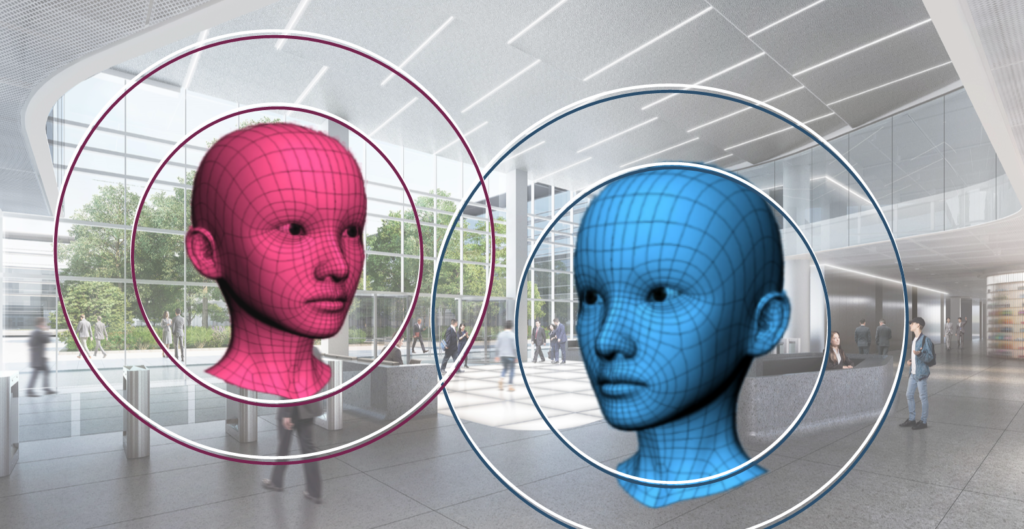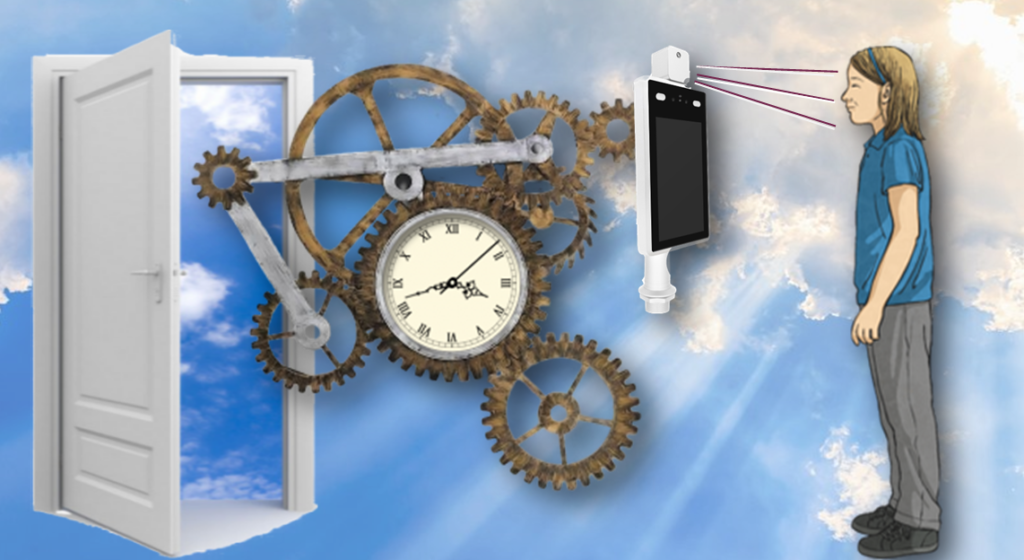Benefits and Controversy of Facial Recognition

IP camera systems have been used for surveillance for many years, but there is controversy when facial recognition is added to the system. For example, there have been concerns about law enforcement using face recognition in public locations. Criticisms against facial recognition include race bias and privacy issues.
Using facial recognition for door access control is quite different from identifying someone in a crowd. When face recognition is used in an access control application, we register and recognize a limited set of people. Privacy is not an issue. This article compares face recognition for door access control to finding a person in a crowd.
IP Camera Systems and Face Recognition Systems
IP camera systems are used for matching facial biometrics. They are used in biometric door access control and law enforcement to find a felon in the general population.
Face Recognition in a Crowd is Complicated
These specialized facial recognition systems use IP cameras to capture the full facial image. The software then uses various computer algorithms to build a definition data set, including machine learning. The latest face recognition systems use 3D algorithms. This system has increased the reliability of identifying a person in a crowd.
How Face Recognition Identifies a Person in a Crowd
High-resolution IP cameras are used to capture facial information. The high-performance algorithm used for 3D identification must work even with a cluttered background. Subjects are not only in motion, but, in many cases, their direction is not optimal for face matching purposes. The system can identify a person even when motion blurs the image by tracking faces through time. Other technical challenges include busy backgrounds, variations in lighting, and the possibility of faces being hidden (occluded) by objects or other people. To learn more, see How Face Recognition Works in a Crowd.
Face Recognition in a Crowd is Controversial
Even though there are many benefits to using face recognition to find a felon, there are social and political concerns. Some of the problems include privacy, racial bias concerns, and the method of policing that shapes the debate on facial recognition. For example, in 2019, the National Institute of Standards and Technology (NIST) investigated facial recognition and found that most algorithms exhibited significant demographic differences in accuracy rates.

Face recognition accuracy has been blamed for excessive false arrests, but human witnesses have also provided misidentification. Recent statistics indicate that improved facial recognition algorithms have removed many of the problems of earlier automated systems and offer a superior and less biased way to achieve identification.
Face recognition in a crowd continues to be controversial, but it shouldn’t be confused with the application of door access control.
Face Recognition for Door Access Control
Face recognition is an accepted method for access control because It is one of the most secure methods for identifying the registered person. It uses a credential that can’t be shared or lost. You don’t have to purchase cards or keyfobs because the credential is their face. Biometric door readers also have an advantage over other forms of door entry because it offers touchless entry control.

Facial recognition is usually done indoors because the changing light makes the recognition process difficult. But some face recognition systems will work outdoors. For example, the TVIP-Face8WP face recognition panel includes unique intelligence that allows operation in changing light and weather conditions.
Face recognition systems use either an IP camera with recognition software that runs on your computer or a biometric door reader that includes built-in software. The door reader attaches to the door controller (or has a built-in controller). The reader-controller connects to the electric lock on the door.
Facial recognition systems require that everyone is registered at the face-recognition reader. For each entry to the system, the manager enters the identification information, such as the person’s name, when they can enter, and what door they can use.
How Face Recognition Works
Face recognition measures various features of a person’s face, such as the distance between the eyes or the position of the mouth to the nose. These geometric measurements or vectors are then coded and stored in a database for later comparison.
There are different processes for identifying a face using a camera, but here are some of the basic techniques that are used.
- Find the face in the video field of view. There is a minimum resolution required to be able to identify a person. It is defined by the number of pixels across the face. You should have 100 to 120 pixels across the face for the system to work reliably.
- The facial recognition software then processes the image. It detects features such as the nose, the eyes, and the mouth. There could be a large number of features captured in this process.
- The facial feature’s information is converted into a digital signature, and this information is stored with the person’s name and other information.
- Each time the camera detects an image, the facial signature is compared to all the signatures in the database.
Face Recognition Combined with Temperature Monitoring
There are combination panels available that combine door access with measuring a person’s temperature. These door access reader-controllers not only provide face recognition credential authentication, but they can also check a person’s temperature and check if they are wearing a mask. See Comparison of Face Recognition and Temperature Access Control Panels to learn more.
Summary of Using Face Recognition for Door Access Control
Privacy and other concerns have made face recognition controversial, but we must differentiate the two types of applications. Law enforcement applications are different than access control. Trying to find one face in a huge population is much more complicated than identifying a person from a small set of registered people. Using face recognition for access control is more secure than using a credential that the person carries. In reality, face recognition is an excellent and safe way to allow access to your facility.
If you need help with your IP door access control, IP camera Systems, or paging systems, don’t hesitate to contact us at 800-431-1658 in the USA or 914-944-3425 everywhere else, or else use our contact form.